Euclid of Alexandria › Chauvet Cave » Ancient origins
Articles and Definitions › Contents
- Euclid of Alexandria › Who Was
- Chauvet Cave › Antique Origins
Ancient civilizations › Historical and archaeological sites
Euclid of Alexandria › Who Was
Definition and Origins
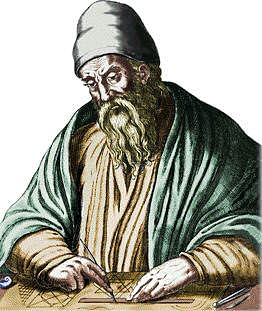
Euclid of Alexandria (lived c. 300 BCE) systematized ancient Greek and Near Eastern mathematics and geometry. He wrote The Elements, the most widely used mathematics and geometry textbook in history. Older books sometimes confuse him with Euclid of Megara. Modern economics has been called "a series of footnotes to Adam Smith," who was the author of The Wealth of Nations (1776 CE). Likewise, much of Western mathematics has been a series of footnotes to Euclid, either developing his ideas or challenging them.
EUCLID'S LIFE
Almost nothing is known of Euclid's life. Around 300 BCE, he ran his own school in Alexandria, Egypt. We do not know the years or places of his birth and death. He seems to have written a dozen or so books, most of which are now lost.
The philosopher Proclus of Athens (412-485 CE), who lived seven centuries later, said that Euclid "put together the Elements, collecting many of Eudoxus's theorems, perfecting many of Theaetetus's, and bringing to irrefragable demonstration things which were only somewhat loosely proved by his predecessors." The scholar Stobaeus lived at about the same time as Proclus. He collected Greek manuscripts that were in danger of being lost. He told a story about Euclid that has the ring of truth:
Someone who had begun to [study] geometry asked Euclid, 'What shall I get by learning these things?' Euclid called his slave and said, 'Give him [some money], since he must make gain out of what he learns'.(Heath, 1981, loc. 8625)
GEOMETRY BEFORE EUCLID
In The Elements, Euclid collected, organized, and proved geometric ideas that were already used as applied techniques.Except for Euclid and some of his Greek predecessors such as Thales (624-548 BCE), Hippocrates (470-410 BCE), Theaetetus (417-369 BCE), and Eudoxus (408-355 BCE), hardly anyone had tried to figure out why the ideas were true or if they applied in general. Thales even became a celebrity in Egypt because he could see the mathematical principles behind rules for specific problems, then apply the principles to other problems such as determining the height of the pyramids.
The ancient Egyptians knew a lot of geometry, but only as applied methods based on testing and experience. For example, to calculate the area of a circle, they made a square whose sides were eight-ninths the length of the circle's diameter. The area of the square was close enough to the area of the circle that they could not detect any difference. Their method implies that pi has a value of 3.16, slightly off its true value of 3.14... but close enough for simple engineering. Most of what we know about ancient Egyptian mathematics comes from the Rhind Papyrus, discovered in the mid-19th century CE and now kept in the British Museum.
Ancient Babylonians also knew a lot of applied mathematics, including the Pythagorean theorem. Archaeological excavations at Nineveh discovered clay tablets with number triplets satisfying the Pythagorean theorem, such as 3-4-5, 5-12-13, and with considerably larger numbers. As of 2006 CE, 960 of the tablets had been deciphered.

First English version of Euclid's Elements, 1570
THE ELEMENTS
Euclid did not originate most of the ideas in The Elements. His contribution was fourfold:
- He collected important mathematical and geometric knowledge in one book. The Elements is a textbook rather than a reference book, so it does not cover everything that was known.
- He gave definitions, postulates, and axioms. He called axioms "common notions."
- He presented geometry as an axiomatic system: Every statement was either an axiom, a postulate, or was proven by clear logical steps from axioms and postulates.
- He gave some of his own original discoveries, such as the first known proof that there are infinitely many prime numbers.
The Elements has 13 chapters (often called "books"), divided into three main sections:
Chapters 1-6: Plane geometry.
Chapters 7-10: Arithmetic and number theory.
Chapters 11-13: Solid geometry.
Chapters 7-10: Arithmetic and number theory.
Chapters 11-13: Solid geometry.
Every chapter begins with definitions. Chapter 1 also includes postulates and "common notions" (axioms). Examples are:
Definition: "A point is that which has no part."
Postulate: "To draw a straight line from any point to any point." (That's Euclid's way of saying straight lines exist.)
Common Notion: "Things equal to the same thing are also equal to each other."
Postulate: "To draw a straight line from any point to any point." (That's Euclid's way of saying straight lines exist.)
Common Notion: "Things equal to the same thing are also equal to each other."
If the ideas seem obvious, that's the point. Euclid wanted to base his geometry on ideas so obvious that no one could reasonably doubt them. From his definitions, postulates, and common notions, Euclid deduces the rest of geometry. His geometry describes the normal space we see around us. Modern 'non-Euclidean' geometries describe space over astronomical distances, at near-light speeds, or warped by gravity.

Fragment of Euclid's Elements
EUCLID'S OTHER WORKS
About half of Euclid's works are lost. We only know about them because other ancient writers refer to them. Lost works include books on conic sections, logical fallacies, and "porisms." We're not sure what porisms were. Euclid's works that still exist are The Elements, Data, Division of Figures, Phenomena, and Optics. In his book about optics, Euclid argued for the same theory of vision as the Christian philosopher St. Augustine.
EUCLID'S INFLUENCE
From ancient times to the late 19th century CE, people considered The Elements as a perfect example of correct reasoning.More than a thousand editions have been published, making it one of the most popular books after theBible. The 17th-century CE Dutch philosopher Baruch de Spinoza modeled his book Ethics on The Elements, using the same format of definitions, postulates, axioms, and proofs. In the 20th century, the Austrian economist Ludwig von Mises adopted Euclid's axiomatic method to write about economics in his book Human Action.
Chauvet Cave › Antique Origins
Definition and Origins
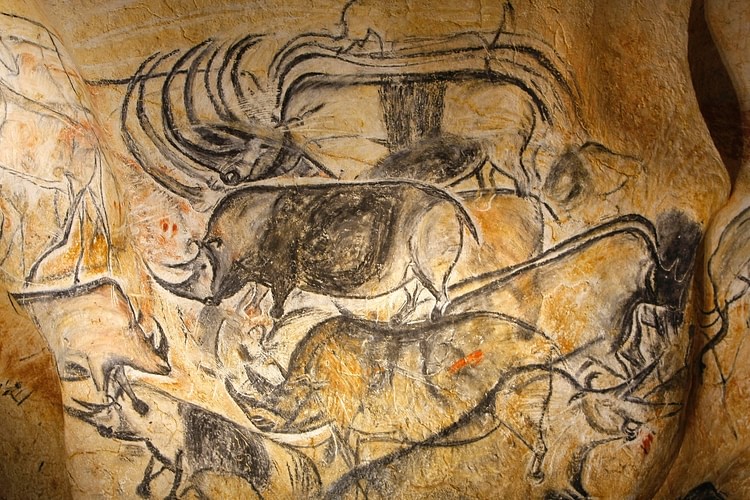
The Chauvet Cave (also known as the Chauvet-Pont-d'Arc Cave) is a Palaeolithic cave situated near Vallon-Pont-d'Arc in the Ardèche region of southern France that houses impeccably preserved, exquisite examples of prehistoric art. Now reliably dated to between c. 33,000 and c. 30,000 years ago, the numerous and diverse animals that dot the interior walls of the cave – both painted and engraved – show such high artistic quality that they were initially thought to have been closer in age to the similarly stunning, but much younger art in caves such as the Lascaux Cave. Its age and artistry have made us reconsider the story of art as well as the capabilities of these humans. The cave has been granted UNESCO World Heritage status.
THE DISCOVERY
On Sunday the 18th of December, 1994 CE, Jean-Marie Chauvet and his two friends Éliette Brunel and Christian Hillaire were following their passion for speleology (the study of caves) and exploring an area on the left bank of the river Ardèche, close to the Pont-d'Arc. A light air flow emanating from a hole alerted them to the possible existence of underground caverns. While making their way through the passages they then discovered some small traces of red ochre, before being blown away by the full magnitude of the hundreds of paintings and engravings.
HUMAN OCCUPATION
The Chauvet Cave was occupied by humans during at least two periods, the first from c. 37,500 years ago to c. 33,500 years ago, and the second from c. 32,000 to c. 27,000 years ago. Around 80% of the registered dates fall around the 32,000 years old mark – which corresponds with the average age of the paintings and engravings and sits snugly in the Aurignacian period.The remaining signs of occupation are from around 27,000 years ago, which ties in with the succeeding Gravettian period.From at least around 21,000 years ago onwards until its rediscovery in 1994 CE, the Chauvet Cave was completely sealed off to visitors due to the entrance having collapsed.

Pont-d'Arc Cavern, Replica of Chauvet Cave
The artists of this cave thus belonged to the Aurignacian culture, the first culture of the Late- or Upper Palaeolithic in Europewhich began when anatomically modern humans first arrived in Europe around 40,000 years ago and lasted until around 28,000 years ago. They were hunter-gatherers whose prey was made up predominantly of reindeer, horses, bison and aurochs, and faced competition from predators such as cave bears and cave lions, panthers and wolves. Aurignacians used a wide range of organic tools, made personal ornaments, figurative art, and even musical instruments, and are thus seen to show the full package of what we call fully modern behaviour.
THERE ARE HUNDREDS OF PAINTINGS & ENGRAVINGS IN THE CHAUVET CAVE, RANGING FROM GEOMETRIC FORMS OF RED DOTS ON THE WALLS, TO HAND PRINTS, TO MORE THAN 420 ANIMAL REPRESENTATIONS.
Hearths have been found within the cave, so it is clear that daily activities of these groups of people took place here, too.Interestingly, the hearths had an additional, non-domestic use – they were also used for producing charcoal, which was part of the artists' tool kit.
The artists of Chauvet Cave had torches at their disposal to cast dim, flickering shadows in the pitch black darkness within the cave. The natural relief of the walls would have been continually highlighted and contrasted, which must have been impressive to witness, especially when combined with the animal shapes used to decorate them. To paint, black paint made from charcoal or manganese dioxide and red paint made from haematite was applied onto the rock surfaces, either by brushes; fingers;using bits of charcoal as pencils; or stump-drawing, which is sticking paint on the wall and then spreading it with your hand or a piece of hide. Paint could also be sprayed onto the walls through tubes, or, for the adventurous, directly from the mouth, across stencils such as hands placed on the wall. Chauvet stands out because here, the walls were often prepared for the imminent paint jobs by scraping them clean first, which really made the paintings pop.
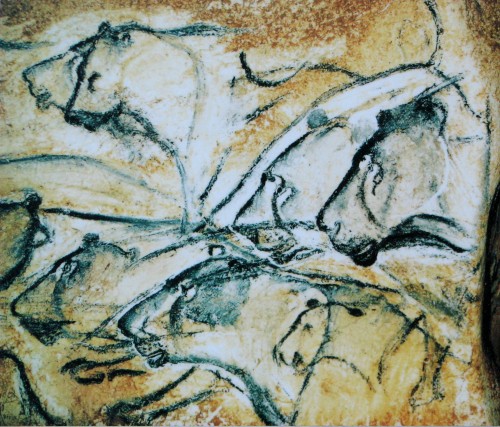
Panel of the Lions (Detail), Chauvet Cave
THE ART
There are hundreds of paintings and engravings in the Chauvet Cave, ranging from geometric forms of red dots on the walls, to hand prints, to more than 420 animal representations. In the majority are animals that were not hunted, such as lions, rhinoceroses, and bears, which is interesting because from the succeeding Gravettian period onward preferences tended to be reversed, with the focus lying on prey animals. Chauvet also stands out for its use of sophisticated techniques such as wall scraping, stump-drawing, and depicting perspective, which are otherwise not as abundantly represented in prehistoric cave art.Although this is a tricky topic, it is thought these Palaeolithic people might have had some sort of shamanistic religion in which the art played a role, perhaps with a dose of hunting magic added to it (where the depicted animals were directly influenced by acting on their images).
THE FIRST PART OF THE CAVE
Some of the first paintings one might bump into after having entered the cave are three cave bears painted in red in a small recess. The artist has cleverly used the relief of the wall to form the shoulders of the biggest bear, as well as stump-drawing the muzzle, the outlines of the head and the forequarters, giving the composition more depth. This first part of the cave, which is characterised by the colour red, is also home to a couple of clusters of large red dots, located in a side chamber, made by dipping the palm of the right hand in liquid red paint and then pushing it against the cave wall. A bit further into the first section of the cave there are some mysterious images, again in red, with geometric bits, that are hard to identify; they could be symbolic signs, or even representations of animals (perhaps a butterfly or a bird with its wings spread?). A large panel of red paintings lies beyond, extending for more than twelve meters, which features mostly handprints, geometric signs, and animals such as lions and rhinos.
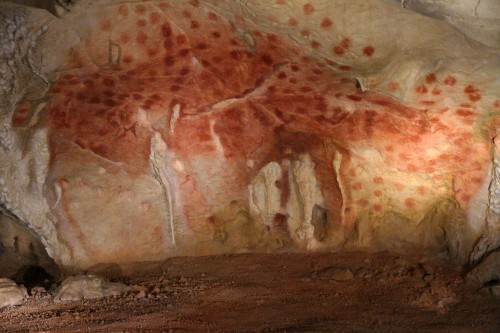
Red Dots Cluster, Chauvet Cave (Replica)
THE SECOND SECTION
A chamber that has no art adorning its walls paves the way into the second section of the cave, where the paintings are now predominantly black rather than red, and engravings step into the limelight, too.
The Hillaire Chamber, situated here, is rife with engravings decorating large hanging rocks; one of them is a remarkable long-eared owl which is shown with its head facing the front while its body is seen from the back, which eternalises the species' cool 180 degree rotation party trick.

Owl engraving, Chauvet Cave (replica)
Further on, more horses jump out, this time drawn in charcoal on the so-called Panel of the Horses. About 20 animals are seen in a unique, naturalistic scene which is rare in Palaeolithic art, and that makes up one of the major pieces of the Chauvet Cave. Taking centre stage are four horses' heads, but the real eye-catchers are two rhinoceroses that stand face to face, horns crossed, confronting each other in just the way male rhinos actually fight in the wild.
A Reindeer Panel and a structure made up of a cave bear skull - decorated with charcoal marks and placed on top of a large limestone block, its hollow eye-sockets peering out into the darkness - further highlight these Palaeolithic humans' versatility.
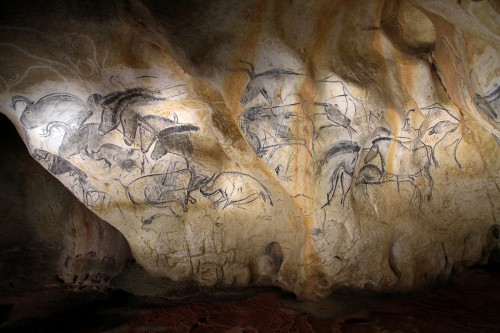
Panel of the Horses, Chauvet Cave (Replica)
EXPLORING THE END CHAMBER
When advancing further into the cave, things just keep getting more spectacular. The end chamber is so richly decorated you hardly know where to look. The first standout piece is the Panel of the Rhinos, drawn with charcoal on rock, featuring nine lions, one reindeer, and a staggering 17 rhinos (who are otherwise very rare in Palaeolithic wall art). The composition has a spatial perspective to it, achieved through leaving gaps in strategic places and decreasing the horn sizes of the rhinos towards the back.
To the right of the central recess, the incredible Panel of the Lions makes up another unique scene in Palaeolithic art; the main scene shows a pride of 16 lions (indicated mostly by just their heads) chasing a group of seven bison. The lions' tense expressions, their poses, and the fact that male lions have joined the females – which happens in nature – leaves us with a snapshot of a hunt in progress. The techniques set this piece apart even further; a scraped surface; shading achieved by stump-drawing; areas left blank to create depth; and enhanced outlines by scraping all serve to make the animals almost leap from the wall.
Some more mysterious shapes than these easily identifiable animals are also present in the end chamber, though. The Panel of the Sorcerer has both black drawings and engravings, and features animals such as lions, a horse, two mammoths and a musk ox, but also an odd shape known as the 'Sorcerer'. It seems to be a composite creature made up of a woman's lower body crowned with the upper body and horned head of a black bison. The last few animals in this chamber are a red rhinoceros, a sketchy rhinoceros, and a mammoth (drawn in charcoal and engraved).
THE CAVE TODAY
Taking the harsh lesson of the Lascaux Cave to heart, which was heavily damaged by the carbon dioxide produced by its countless visitors, the Chauvet Cave is sealed off to the public. It continues to be studied by an interdisciplinary team, originally led by Jean Clottes, and since 2001 CE by Jean-Michel Geneste. A watchful eye is kept out for any alarming signs. To soothe the frantic interests of people fascinated by our artistic ancestors - again following Lascaux' example - a replica (known as the Pont-d'Arc Cavern) has been built close to the original cave.
See other Related Contents ››
LICENSE:
Article based on information obtained from these sources:with permission from the Website Ancient History Encyclopedia
Content is available under License Creative Commons: Attribution-NonCommercial-ShareAlike 3.0 Unported. CC-BY-NC-SA License